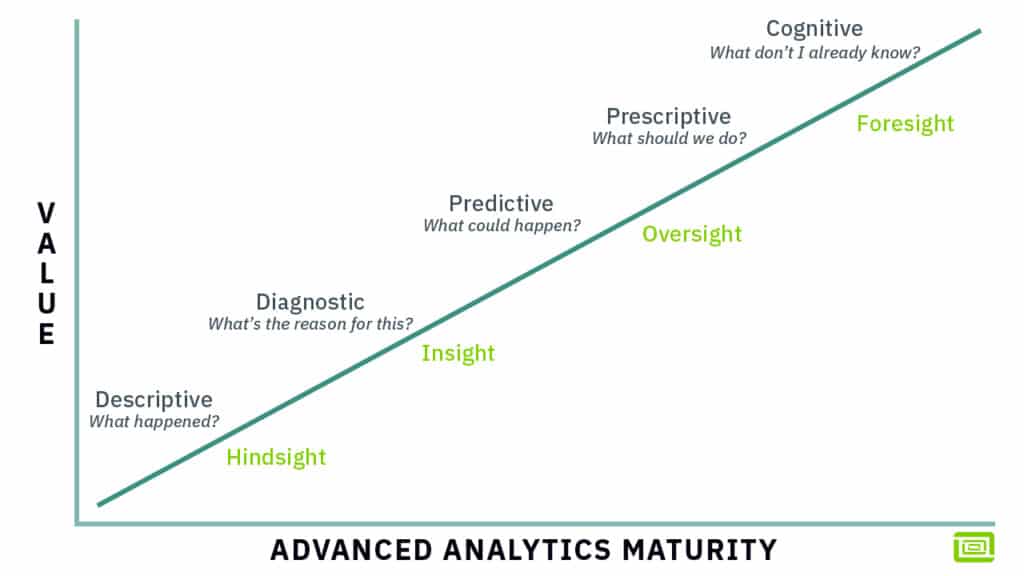
In an ever-evolving technological landscape, new potential explodes in the supply chain space daily. With improving machine learning and artificial intelligence capabilities, advanced analytics are shifting, becoming a more attractive option to leaders across industries. But how can you incorporate advanced analytics into your supply chain flow? What do you need to have in place before you can do it to guarantee success? Let’s take a look.
Statistical analysis is a vital component of the supply chain. In the traditional sense, analytics apply mathematics and statistics to discover patterns within the supply chain and identify opportunities for optimization.
Your organization can dive into five types of analytics: descriptive, diagnostic, predictive, prescriptive, and cognitive.
- Descriptive analytics answers the question, “What happened?” It looks at past and present data and organizes the information into clear patterns.
- Diagnostic analytics focus on identifying the root cause of an issue, assessing the question, “Why did this happen?”
- Predictive analytics takes advantage of more complex statistical methods (including machine learning and AI) to assess “What could happen?” It uses historical information to make forecasts about the future.
- Prescriptive analytics considers the present situation, meshing current data with simulation algorithms to answer, “What should we do?”
- Cognitive analytics are those that engage machine learning and artificial intelligence to draw conclusions beyond those that standard statistical operations can identify. “What don’t I already know?

Advanced analytics targets all types of the above analytics to draw rich conclusions about your organization. It improves the quality of all types of analytics with faster, more accurate processes.
Advanced analytics have the capability to improve your supply chain across the board. When engaged correctly, advanced analytics can help you:
- Optimize business decisions related to demand, inventory, production, and distribution
- Reduce cycle times
- Gain organizational visibility and increase your bottom line
But integrating advanced analytics into your organization isn’t always as simple as grabbing a new piece of software. You’ll need to ensure your company is prepared culturally and technologically for this new type of innovation.
While advanced analytics seem like a no-brainer, incorporating them into your organization isn’t as cut-and-dry as it seems. Before integrating advanced analytics into your organization, you’ll want to ask yourself some questions about your organization and supply chain process:
- Does your current team have a culture that will embrace advanced analytics?
- What new roles do you need in your supply chain team?
- How should your team be organized to efficiently run the supply chain while driving innovation through advanced analytic processes?
- Are your current supply chain systems sufficient to leverage new data sources and enable advanced analytics?
- Can you, and are you willing to, automate routine analytic activities?
- Will your organization utilize the advancements that come from analytics?
Clearly, there are many things to consider before you incorporate advanced analytics into your supply chain process. At Logility, we alleviate the stress of ensuring your organization is ready, taking the burden of preparation off your shoulders. Our advanced analytics solution meets you where you are in your analytics maturity cycle, bringing you to the next level regardless of your present status.
Once you’ve assessed your organization’s readiness for advanced analytics, you’ll no doubt want to begin integration straight away. However, you will want to ensure your advanced analytics initiative can target all five levels of analytics: descriptive, diagnostic, predictive, prescriptive, and cognitive. The richest advanced analytics programs provide a comprehensive look at your data, with seemingly endless applications.
You don’t need to, and probably don’t want to, implement every advanced analytic at the same time but you need to ensure your chosen solution will support you through the entire advanced analytics maturity cycle; as your organization’s needs grow the solution can provide the additional value.
At Logility, we recommend leveraging advanced analytics capabilities alongside your pre-existing traditional methods. Once these new capabilities are well-integrated within your organization, you can begin collaborating not only within your company but also with suppliers, customers, and more to optimize their impact.
Integrating advanced analytics is an exciting initiative that is bound to have impressive results for your organization. Planning ahead will ensure your company is set up for advanced analytics success. Use the above guidelines to ensure your organization has adequate infrastructure in place to support your analytics expansion. Consider collaborating with industry experts, like our team at Logility, who will deliver seamless and optimized advanced analytics to your supply chain.
Five Questions to Ask Advanced Analytics Solution Providers
With hundreds of advanced analytics tools available in the market, a sound selection strategy that integrates business requirements accurately is more important than ever.
Free White Paper

